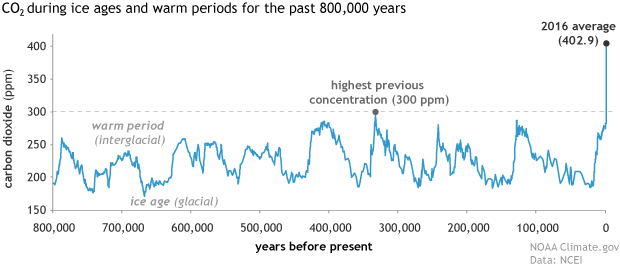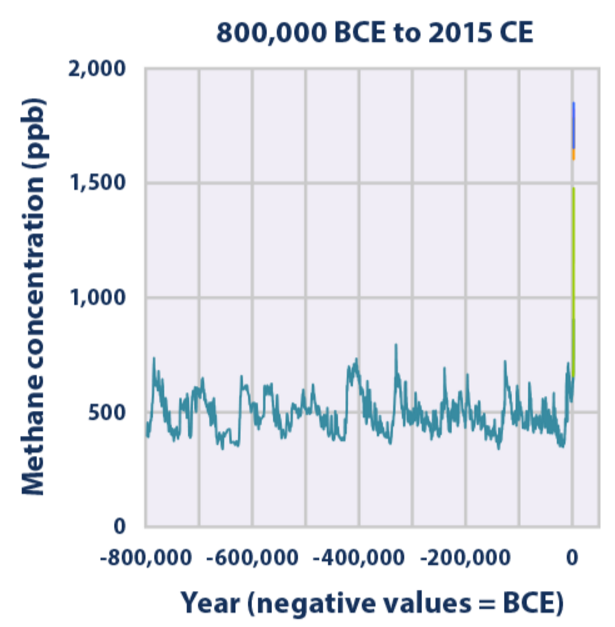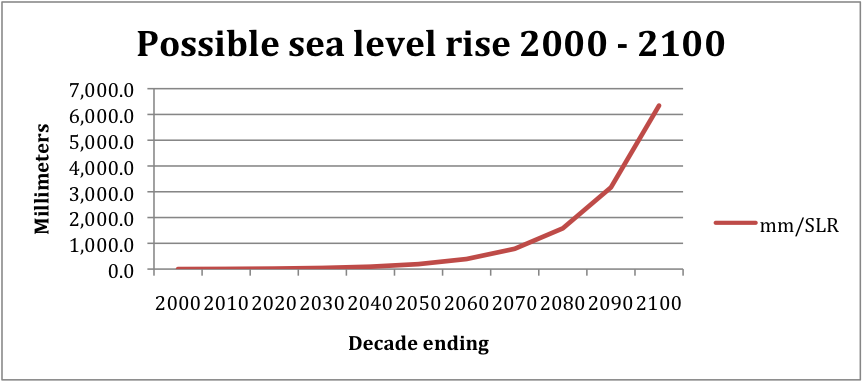
It snows in Antarctica and has done so every day for millions of years. As it snows, air is trapped among the snowflakes. As snowflakes accumulate their combined weight increases, compressing lower layers into ice. Air trapped among the snowflakes become air bubbles in the ice and the deeper the ice, the older the air bubbles.
Drilling down through the ice has recovered ice cores containing air bubbles over 800,000 years old. Placing ice from these cores in a vacuum tube, then allowing it to melt releases ancient air. This is then analysed to find out what gases are present in the recovered air sample, an exercise which has been repeated again and again from air samples stretching back over millennia.
This air is analyzed, revealing the changing composition of Earth's atmosphere, particularly carbon dioxide (CO2) and methane (CH4) in this 800,000 year record (fig 1).

Fig 1. minimum and maximum volume of CO2 correspond to the coldest period of ice ages and thermal maxima during interglacial periods.
The record shows that during the coldest periods – ice ages – the average concentration of CO2 in the atmosphere has been found to be 175 ppm. By contrast, during thermal maxima, concentration rises to around 285 ppm. By mid 2017, CO2 concentration had reached an unprecedented 406.5 ppm, or 40% above normal.

Fig 2 shows that changes in CH4 concentration (measured in parts per billion), vary between cold (285 ppb) and warm periods (700 ppb). By 2017, CH4 concentration was estimated to have reached 1860 ppb, or 267% above the normal maximum. Graphic: EPA/Wikipedia.
Previous changes in the level of atmospheric CO2 and CH4 over the last 800,000 years have been induced by variations in Earth's orbit (called Milankovitch cycles) and have taken 10,000-15,000 years to occur. By contrast, changes above their normal maxima have occurred over the last 100-150 years – 100 times faster than the increase initiated by orbital change.
This does not mean that the environment will respond 100 times faster but a proportional response will eventually occur. Emissions of this magnitude can not be made with impunity. There will be consequences which are likely to severely affect our ability to survive as a species on this planet.
This should not come as a shock. Climate Scientists have, for decades, been warning us of the likely outcome of practices causing an increase in CO2/CH4 emissions. Their advice has been ignored and as a result, we can, at the very least, expect:
The French President, Emmanuel Macron recently warned that signatories to the 2015 Paris Accord were failing to meet their commitment to reduce carbon emission and consequently the target of limiting global warming to 1.5°C or, at most, 2°C above preindustrial levels, would not be met. At the present rate of emissions average global temperature could rise more than 3°C by 2100, a prognosis indicating a doubling of CO2 concentration since the industrial revolution.
In 2017 average global temperature was almost 1°C above the preindustrial average, even though the warming effects of an El Niño were absent. Greenhouse gas emissions estimated at over 37 Gt. in 2017, accelerating at 2% per annum, makes warming of over 3°C likely. In many regions, temperatures will rise by far more than 3°C, particularly in the Arctic where mean annual temperature could increase by 9°C.
Two positive feedbacks make this a likely outcome. Firstly, as surface temperatures increase the atmosphere is able to hold more moisture in the form of water vapor – a very powerful, usually short-lived greenhouse gas. This could increase cloud cover and raise wet-bulb temperatures rendering some locations uninhabitable for some part of the year. Second, as surface temperature rises it thaws permafrost enabling resumption of biota decay, often creating water covered land surfaces and release of carbon, in the form of CH4 or, where oxidation is possible, CO2, which vent to the atmosphere.
Rising surface temperature also affects ability of oceans and vegetation to function as carbon sinks. Oceans are a major carbon sink presently absorbing about 33% of human CO2 emissions. However, as sea surface temperature warms, it induces more vigorous overturning, bringing deep carbon rich water to the surface which vents to the atmosphere until equilibrium is reached, making the oceans a net source of CO2. Rising sea surface temperature not only kills corals but also reduces ability of sea water to absorb CO2 from the atmosphere.
The capacity of the other great CO2 sink, woody vegetation, is also affected by global warming. As surface temperature increases, so does the risk of fire, often destroying large areas of forest which hitherto have been an important sink, sequestering CO2 from the atmosphere by converting it to sugars promoting woody growth. Burning of woody plants results in the release of CO2 and, at least in the short term, reduces the capacity of vegetation to absorb this gas. The result: more rapid rise of CO2 in the atmosphere and an increased rate of global warming.
One of the more visible effects of global warming is the loss of snow and land based ice from glaciers. Glaciers feed rivers on which humans are heavily dependent for transport, electricity generation, irrigation and food production. All of these are threatened as glaciers recede and water flow from them initially floods, then diminishes. An even greater threat comes from loss of land based ice, particularly from the West Antarctic and Greenland ice sheets.
We know that late in the last interglacial period (the Eemian ~128 – 118 kya) global mean sea level was 6-9m higher than at present. Atmospheric greenhouse gas concentrations are now substantially higher than during the Eemian and mean global temperature will exceed the Eemian this century. Despite this, the IPCC 5th Assessment Report(see Ch.13) and reticence among climate scientists maintain the fiction that by 2100 mean sea level will have risen by less than 1m.
This is dangerous since public policy is formulated on this assurance and policy is implemented in the form of land classification and building approvals given. The result is that buildings and infrastructure are located on land which is likely to be flooded in the future with the loss of assets and disruption of services and lives. It also enables Governments to ignore what is likely to prove a very real threat to existing infrastructure on which entire economies - and populations - rely for their survival.

Fig. 3. Projected sea level rise if mass loss from ice sheets continues to double per decade until 2100. Data based on actual annual rate of ice mass loss shows it is more than doubling per Note relatively slow but evident rate of increase in predicted sea level rise until 2030.
In their Paper, Hansen et al 2016, Dr James Hansen and 18 distinguished colleagues conclude that over the next 50-150 years multi meter sea level rise will occur. The time range arises from the fact that the speed with which ice sheets respond to global warming is not accurately known. If, as at present, mass loss from ice sheets continues to double per decade, this is likely to occur sooner rather than later.
Discharge of large volumes of fresh, cold water from the Greenland Ice Sheet will cool the region enough to increase polar-tropical gradients and possibly slow - but not stop - on-going loss of ice from Greenland. It is also likely to lower sea surface temperature in the North Atlantic, increasing thermal gradients between tropical and polar regions and enabling development of superstorms characteristic of the Eemian - more violent than the worst storm we have so far experienced. The argument for this is discussed by Dr Hansen in this video.
Loss of ice mass in Antarctica is discharging fresh water onto the surface of the Southern Ocean, disrupting overturning circulation and trapping relatively warm water near the ocean bed. This is likely to increase the rate of mass loss from the West Antarctic ice sheet which is particularly vulnerable to melting by warm water flowing over the seabed on which it rests.
An increase in the rate of mass loss from the West Antarctic Ice Sheet may compensate for slowing in loss expected from the Greenland ice sheet. The net result may be continued decadal doubling of ice mass loss and accelerating rates of sea level rise. This effect may not have been fully considered by the IPCC.
The immediate problem which faces us is that atmospheric concentration of greenhouse gasses are already well above those which brought about the Eemian maximum and its attendant sea level rise. As a result of ongoing emissions, it is likely that mean global temperature will exceed the Eemian, possibly by as much as 1°C (or 3°C above preindustrial) by 2100, a very dangerous increase which could result in a violent, destructive climate.
A multi-meter sea level rise of Eemian proportions, even without a violent climate, poses serious problems for our survival. It has the potential to erode coastlines by as much as 20 km., in the process inundating vast swathes of agricultural land, flooding thousands of coastal towns and cities and destroying key sections of vital infrastructure – particularly that on which transport relies. This would prove highly disruptive, effect much of the global population and potentially result in its reduction.
This need not be an inevitable outcome. We have the ability to reduce carbon emissions by imposing an effective carbon tax and electrification of transport, thereby reducing combustion of fossil fuels. However, the current state of technology suggests that even if we rapidly reduce greenhouse gas emissions over the next two decades, we may be unable to slow the onset of catastrophic climate change and sea level rise much beyond the middle of next century.
Clearly we need to do more to ensure that the transition from burning fossil fuels to meet our energy needs is achieved more rapidly. Both National and International lending institutions could be required to cease lending for projects which involve burning of fossil fuels to generate electricity or meet other energy requirements. Those same institutions should be encouraged to provide increased funding, both concessional loans and grants, to accelerate construction of renewable energy generation and storage projects particularly in developing nations.
Globally all levels of government need to adopt mitigating actions which assist reduce reliance on and consumption of energy now produced by burning fossil fuels. National Governments need to adopt public policy, supported where necessary by legislation, which encourages and facilitates adoption of renewable energy as the fuel used for all forms of land transport, industrial machinery and other applications which now rely on burning fossil fuels.
We know that injection of powdered iron into the ocean promotes rapid increase of phytoplankton which are able to absorb and sequester CO2 from the atmosphere but less certain of the effects of that increase on the environment. We know that use of fast reacting silicate rock dust on farmland absorbs CO2 from the atmosphere and enhances soil fertility but its production, transport and use can release dust into the atmosphere injurious to the respiratory system of many animals – including us.
For these reasons increased investment is needed for research, development and appropriate use of technology that enhances the ability of natural sinks to absorb and sequester CO2 already in the atmosphere. International agreement on its deployment and safe use is also required to ensure that undesirable side effects, such as those noted above, are avoided.
Unless we take these or similar measures it may not be possible to avoid eventual onset of climate conditions and sea level rise inimical to our longer-term survival on this planet.
Posted by Riduna on Tuesday, 6 March, 2018
 |
The Skeptical Science website by Skeptical Science is licensed under a Creative Commons Attribution 3.0 Unported License. |